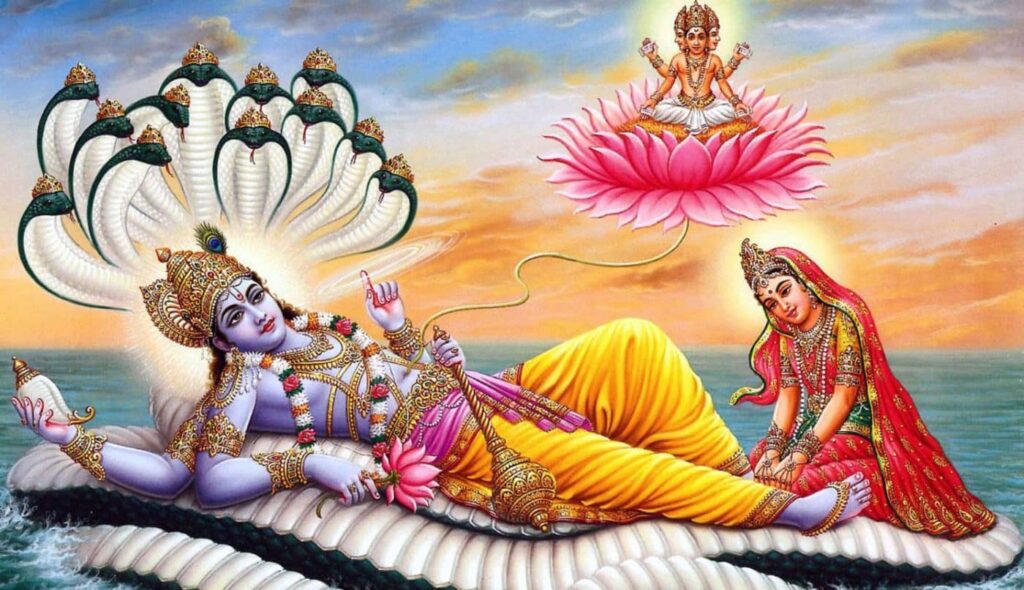He is also called Narayana, which means the shelter, resting place, or ultimate goal of all living entities. Lord Vishnu is also called Hari, or one who removes the darkness of illusion. This illusion ultimately means the false idea that the living beings live separate from, or without connection to, the Lord.
References to the glories of Lord Vishnu are found in ancient holy books such as Rig Veda. Many of them are in relation to his form as Vamandeva, the dwarf incarnation who begged for only three steps of land from King Bali, and with those three steps, he covered the whole universe.
Lord Vishnu is often portrayed resting on the huge serpent Shesha. Thousand heads of Shesha are seen all turned inward representing a tranquil mind and looking toward the absolute truth of Lord Vishnu. Lord Vishnu is also seen in the yogic sleep called yoga-nidra. The yoga-nidra (yoga or the root yuj meaning to connect or join) is a cosmic sleep wherein the Lord is focused on the infinite reality of his own identity.

His four hands represent the four directions and indicate his absolute power in the four corners of the universe. Each hand holds an item, such as a disc, lotus, conch, and mace.
- The conch represents the five universal elements. When the conch is blown, it is said to produce a sound related to the original vibration of universal creation, or om. The Lord also blows his conch in calling everyone to turn to the higher reality rather than remaining in the darkness of material existence.
- The disc or chakra signifies the universal mind or awareness. It rids all darkness wherever it appears and thus shows the path to higher awareness.
- The mace represents the cosmic intellect or knowledge. It is called Kaumodaki, meaning that which captivates the mind. It is also associated with time, which destroys all, and is thus also related to Kali, the power of time.
- The lotus being twirled in his hand shows the revolving or changing nature of the universe. It also indicates the real purpose of human existence, which the Lord invites all to follow.

Sometimes, Lord Vishnu is also seen riding on his carrier bird, Garuda (गरुड). According to the Puranas, Garuda is a son of Kashyap and Vinita, who was a daughter of Daksha. This is a half-man and half-eagle bird, whose name means “wings of speech”. He has the head of an eagle with a red beak and feathered wings, and two arms like a man. With the color of molten gold, Garuda appears huge with a fierce expression.
Lord Vishnu, also called Narayana or Hari, is the maintainer of the universe and the complete cosmic creation. He is called Vishnu because he overcomes all. He represents sattva-guna or the mode of goodness by which everything is sustained.
Do You Know?
Vishnu transformed himself into a half-man half-lion creature to kill a demon who could not be killed by a human.

Dashavatar
Dashavatar denotes the incarnation of the Lord Vishnu into 10 mortal forms when the Dharma on earth is threatened by human sins. The 10 human forms of Lord Vishnu include: Krishna, Ram, Kalki Avatar, Matsyavatar, Narsimhavatar, Kurmavatar, Buddha, Parshuram, Varahavatar, and Vamanavatar.
Names of Vishnu
Various names of Lord Vishnu and their meaning is tabulated below;
| Name | Meaning |
| Hari | ‘Hari’ means, he who unties (harati) the knot of material desire in the hearts of the living entities. Hari removes obstacles or the sorrow of illusion. |
| Krishna | ‘Krishna’ is divided into two syllables ‘Krish’ and ‘na’. ‘Krish’ means, he who attracts the minds of all living entities, and ‘na’ means ‘the supreme transcendental pleasure’. These two syllables combine to become the name ‘Krishna’; |
| Rama | ‘Rama’ means, he who delights (ramayati) all living entities, and it also means ‘he who is full of transcendental bliss. |
| Narayana | The universal shelter |
| Govinda | Saver of the Earth and protector of cows |
| Madhava | Lord of knowledge |
| Madhusudana | Because Vishnu killed a demon named Madhu. Madhu also means honey or sweetness. |
| Trivikrama | The one who conquered the three planetary systems |
| Vamana | The dwarf incarnation |
| Shridhara | The possessor of fortune |
| (Sanskrit: हृषीकेश) | Lord and controller of the senses |
| Padmanabha | Whose navel produced the universal lotus |
| Damodara | Who is self-restrained |
| Sankarshana | Who reabsorbs |
| Vasudeva | One who dwells within |
| Pradyumna | Who has the most wealth |
| Aniruddha | Who no one can oppose |
| Purushottama | Best of all men |
| Adhoksaja | The expanse of the universe |
| Nrisimha | The half-man and half-lion form |
| Achyuta | The inconceivable |
| Krishna | The dark and all-attractive one |
| Janardana | He who gives rewards |
| Upendra | The brother of Indra |
| Pundarikaksha | Pundarika is a lotus, usually the white lotus. Pundarikaksha means one with lotus eyes. |
